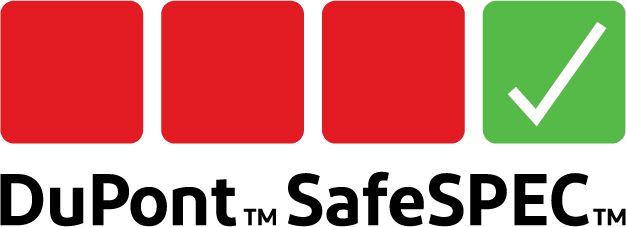Addressing Ammonia Refrigerant Risks
By Fernando Marques Rosalvo
Work Safety Technician, Frigorifico Better Beef

Ammonia (NHO3) is a common refrigerant used in large-scale cooling systems. It is also a toxic gas that can cause severe irritation to the mouth, throat, respiratory tract and stomach if inhaled or ingested. The U.S. Occupational Health Safety and Administration (OSHA) considers ammonia exposure at levels above 300 ppm “dangerous to life and health.” Ammonia is also flammable at high concentrations, a danger that is amplified when it is mixed with lubricating oils.
Ammonia-based cooling systems are widely used in the meat-packing plants of Brazil. My employer, Frigorifico Better Beef, was founded in 2003 and maintains an industrial unit with nearly 900 employees near the city of Rancharia in Brazil’s São Paulo state. The use of ammonia refrigerant in Frigorifico Better Beef’s factory park is accompanied by a number of provisions that allow the plant’s emergency response personnel to intervene within the appropriate technical and safety parameters, including the use of safety equipment, compressed-air respirators and self-contained breathing apparatus (SCBA). (If exposure risks above 300 ppm exist, use of an approved SCBA is recommended.)
Preparing for emergency response to ammonia leaks and spills requires a great deal of education and practice. It is important to define an organizational structure, including roles and responsibilities, to familiarize emergency response personnel with the facility layout, as well as available resources and equipment; and to establish and practice, through repeated simulations, the emergency procedures that must be followed to mitigate the hazards of an ammonia incident.
With these factors in mind, in July 2015 we initiated an Emergency Response Plan and Risk Management Program at Frigorifico Better Beef, training and qualifying factory personnel in rescue methods and valve-closure procedures to be used in the event of an ammonia leak, all while dressed in Tychem® 10000 suits. We developed the program in conjunction with other companies in the locality that use ammonia in their industrial processes, as well as the nearby fire department. We held additional training in October 2015 and again in July and November 2016.
The program continued in the nearby city of Presidente Prudente. With the participation of the Specialized Work Safety and Medicine Service (SESMT) of Frigorifico Better Beef, we carried out a workshop, developed in accordance with Regulatory Norm 36 of the Ministry of Labor and Employment, showing the importance of using Level A suits when fighting possible ammonia leaks. In October 2016, volunteers from the Presidente Prudente Fire Brigade performed an ammonia leak simulation in a meat-packing plant environment while wearing Level A suits.
In April 2017, Frigorifico Better Beef collaborated again with the Rancharia Fire Department to provide machine room operators with training in the use of Tychem® 10000 suits in the event of an ammonia leak. Teaching opportunities at Expomeat, a trade show for the meat-packing industry, followed.
I’m pleased to share that as a result of these efforts, we were honored with the DuPont Safety Award for 2017.
Back to Top
Protective Apparel for “Unusual” Situations
By Michael Halliwell
M. Eng., CESA, EP, P. Eng.

A number of years ago, I was involved in an environmental investigation that became something of a mystery. The site in question was a former power plant turned restaurant. Groundwater test results had revealed the presence of polycyclic aromatic hydrocarbons (PAHs), but their source was unknown. Several rounds of drilling and sampling later, we discovered what appeared to be the clean-out for a forgotten underground tank.
Entry to the underground area was through a hole jackhammered through the concrete roof of the power plant’s former colliery. We knew that lifelines, self-contained breathing apparatus (SCBA), a man watch and a bottle watch would be needed, but the “what to wear” question still posed a problem. There were hydrocarbons in the tank (likely a back up fuel supply dating from when the power plant switched from coal to natural gas) and we knew that it was likely leaking (the PAHs in the groundwater), but what else was down there? The bedding material was powdery and several wrapped pipes were visible in pre-entry photographs.
At the time, our apparel options were limited to Tyvek® coveralls, Nomex® coveralls or a Level A encapsulating suit. The first was great to keep “stuff” off of entrants; the second was great for flash protection; and the third was prohibitively expensive for a one-off project. So we ended up using the Nomex® coveralls, changing and laundering them after each work day. Additional protection like Tyvek® would have been nice, but Tyvek® coveralls melt when exposed to a flash or fire.
Fortunately for us, the entry went well with no incidents. We identified two tanks in the former colliery; were able to confirm the presence of Bunker C fuel (almost like tar after 50 years) in both tanks; identified fly ash used to bed the tanks (powdery and loaded with heavy metals), as well as 85% chrysotile asbestos pipe wrap. We encountered a great hodgepodge of things you don’t want to be exposed to. A bit of extra protection would have been nice during the work—rather than cleaning up afterwards. Ultimately, the tanks were cleaned out and removed with the pipe wrap and fly ash. The space was converted to storage.
Looking back, our protective garment choices weren’t ideal. We needed both chemical protection and flame resistance for the job, but at the time there weren’t any good options short of going to a Level A encapsulating suit and taking care to prevent snags during a tight entry.
There have been numerous advances and new products over the last 10 years, and I’m glad to see that now there are options available for this type of situation. An example is the new Tychem® 2000 SFR garment with secondary flame resistance. Had it been available at the time, it would have been the best choice for the challenge we were dealing with.
The moral of the story? Know your options in protective apparel. There just might be something that wasn’t available that long ago to fit an unusual circumstance.
Back to Top
Protection Against the Scourge of Opioids
By Mark Tartaglia
MSPH, CIH, Senior CIH Consultant, DuPont Protection Solutions

Opioids are an important class of drugs prescribed to patients to help them manage chronic pain due to surgery, cancer treatment and many other medical conditions. Unfortunately, opioids are also highly addictive and subject to abuse.
In the last several years, one opioid-fentanyl has received a tremendous amount of attention in the news. Fentanyl and several of its derivatives are synthetic opioids that have newfound use in the illicit drug market. Fentanyl is approximately 100 times more potent than morphine and 50 times more potent than heroin. Drug dealers, in their greed and disregard for life, have begun lacing heroin with these cheap synthetic opioids, leaving unsuspecting addicts vulnerable to overdose.
Another unfortunate consequence of this practice is the exposure risk these extremely hazardous drugs pose to the law enforcement, emergency medical technicians (EMTs) and prison personnel who must deal with what has become, in essence, a public health crisis.
As is the case when dealing with any hazard, the level of risk these substances pose depends on the exposure potential. For example, the risk to law enforcement when raiding an active clandestine drug lab is greater than that of collecting evidence in a drug den, and the latter risk is greater than that faced by EMTs rendering aid to someone who has experienced an overdose. Risks need to be determined by conducting a thorough hazard risk assessment.
Typically encountered in powder form, fentanyl and its derivatives, as well as laced heroin present both inhalation and dermal exposure risks. The greatest exposure and subsequent potential respiratory failure risk is attributable to inhalation. Nevertheless, dermal contact poses a serious secondary exposure risk that must be protected against.
In many cases, standard Tyvek® garments are acceptable protection when handling hazardous particles. However, in the case of fentanyl, the drug’s extreme potency must be considered. When handling fentanyl and similar highly potent powders, use of a taped-seam garment is highly advisable.
For high-risk exposure incidents, such as raids of production and milling labs where a SCBA may be required, an encapsulating suit like Tychem® 10000 or Tychem® 10000 FR may be needed to protect both the responder and the respirator equipment used. For lower-risk situations where the chance of dermal contact is minimal—when handling an overdose victim, for instance—Tyvek® 600 and Tyvek® 800J may be excellent options.
In all cases, the end-user’s hazard risk assessment should determine the necessary personal protective equipment (PPE) ensemble.
For additional information about opioid hazards, visit the following resources:
- Centers for Disease Control (CDC), NIOSH Workplace Safety and Health Topics.
- The InterAgency Board, Recommendations on Selection and Use of Personal Protective Equipment and Decontamination Products for First Responders Against Exposure Hazards to Synthetic Opioids Including Fentanyl and Fentanyl Analogues, August 2017, (PDF).
- The American College of Medical Toxicology (ACMT) and American Academy of Clinical Toxicology (AACT) Position Statement: Preventing Occupational Fentanyl and Fentanyl Analog Exposure to Emergency Responders, July 12, 2017.
- Drug Enforcement Administration (DEA), Fentanyl: A Briefing Guide for First Responders, June 2017.
Disaster in the First Person: Responding to Hurricane Harvey
By Bobby Salvesen
Resource Specialist, New York Task Force 1, FEMA,
Deputy Chief Instructor for the Nassau County Fire Service Academy

Hurricane Harvey was on a collision course with the Gulf Coast in late August 2017. News outlets were reporting that the storm was unlike any other in recent history due to its speed and intensity. Harvey had developed into a tropical storm on August 17 and by August 25 was a Category 4 hurricane. After making first landfall near Rockport, Texas, the storm dropped an unprecedented amount of rain on the area (51.88 inches on Cedar Bayou near Highlands, Texas, a Preliminary Lower 48 tropical cyclone record) and caused more than $70 billion in damage.
As members of New York Task Force 1 (NYTF-1) of the Federal Emergency Management Agency’s (FEMA) Urban Search and Rescue Response System, we were tasked with deploying to the region a Type 1 team made up of a number of specialties, including, but not limited to: K9 building collapse; rescue; swift water rescue; and HazMat. In order to fulfill these requirements, we needed about 80 people, a lot of equipment and the vehicles to carry it, including four tractor trailers, eight Sprinter vans, four vans, three pickup trucks with boat trailers, one command car and a K9 unit.
I was assigned to the role of Hazardous Materials Specialist. This was my first deployment with the team and it felt extremely hectic. It all had happened so suddenly: When I arrived at work one day, I was immediately told to get my personal belongings because I was going to be deployed for two weeks. I rushed home, packed, informed my family that I was being deployed, and rushed to the deployment site. We pushed off from Brooklyn, New York, to our anticipated destination of San Antonio, Texas, at four in the morning.
As you can imagine with a deployment of this magnitude, multiple teams were en route and plans were changed seemingly on an hourly basis. In fact, as far as I can find out, every team in the United States was activated. The support and command structure did everything in their power to convey this information to the field, but it was overwhelming to say the least.
From the perspective of HazMat specialists, we were in a supportive role in a defensive posture. Our job was to support the search and rescue operation, making it safe for the effort to continue. Our metering abilities consisted of radiation detection, four-gas metering and various other basic meters.
Hurricane Harvey had dumped many feet of water over a rather large area, some of which was moving quickly, and much of which was standing still. Both scenarios proved equally challenging. The moving water could quickly pull a member into an unsafe position, and the standing water began leaching out fertilizers, sewage and other contaminants into the flooded areas.
Members of the search teams were routinely put in the water in order to do their searches. Our main focus was to properly decontaminate them once their missions were complete. All equipment that came in contact with water needed to be thoroughly decontaminated after every mission. To formulate a plan on how to do this, members of all teams began collaborating, using talking groups and discussing methods of decon and water transport.
For the decon effort, NYTF-1 decided to use empty equipment totes lined with a waterproof tarp and filled with working hydrant water. We would load them onto a flatbed trailer along with a sump pump, hose, generator and nozzles and go to the field to decon rescue personnel after they came out of the water. The Hazardous Materials branch worked closely with the Medical branch to address any decon issues that arose and presented as medical conditions. We mandated that all members wash their hands and face before eating or touching anything. Soon it was a habit of all members and thankfully we did not encounter any medical issues from the contaminated water.
Our team only handled one confirmed HazMat condition. I and another member of the HazMat team were tasked with addressing a leaking 250-pound propane tank that had floated off its moorings in a residential area. To get to the site, we boarded fan boats along with U.S. Forest Service agents and a swift water/rescue component of NYTF-1. When we arrived on scene, we saw that the tank was visibly releasing propane from a broken vapor line. Given the topography and the proximity to homes, it was determined that the best plan was to let it continue leaking.
We were demobilized on September 9 and returned home from Robins Air Force Base in Georgia. The resiliency of the people of this area was truly astounding as they banded together to share, help and support each other. Without their fortitude, the disaster would have been much worse.
Back to Top
HazMat Through History: Opiates and Opioids
By Daniel Hammel
Garments Inside Sales Manager, DuPont Protection Solutions

Opium has been used by humans since prehistoric times. The first known cultivation of the opium poppy was in Mesopotamia circa 3400 BCE, and the plant was introduced to other cultures over the millennia because of the euphoria its use brought. Hippocrates began providing opium medicinally to others circa 400 BCE. It was around this time that opium’s addictiveness was recognized.
Morphine was developed from opium in 1806 and used to treat several ailments, but its ability to manage pain made its use very common in wartime. After the Civil War, many soldiers battled morphine addiction. Heroin was developed in 1874 to serve as an alternative to morphine. At the time, its production and use in the United States was legal, and it was marketed as a cough suppressant that was suitable even for children. Heroin didn’t become fully illegal in the United States until 1924.
Synthetic opioids possess characteristics of opiates; however, they are not derived from opium. As doctors try to balance the need to manage chronic pain with the high risk of addiction, opioids such as hydrocodone and oxycodone are among the most-commonly prescribed drugs in the United States.
Fentanyl, an opioid that is significantly more potent than morphine and heroin, is used legitimately to treat severe pain from surgery or cancer, and is often applied via a time-release transdermal patch. Because of its potency, fentanyl is also used illicitly, either on its own or laced with other harmful but less-potent drugs, like heroin. Fentanyl is of particular concern for law enforcement because it poses both a respiratory and dermal exposure threat.
To find out which DuPont products offer suitable protection against exposure to fentanyl and other opioid hazards, visit www.SafeSPEC.DuPont.com.
Products and/or sales questions?
Share your stories, tips and tricks.

Resource library
Find technical information, videos, webinars and case studies about DuPont PPE here.


